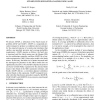1632 search results - page 105 / 327 » Topological Analysis of Refinement |
AAAI
2008
15 years 1 months ago
2008
A recurring theme in AI and multiagent systems is how to select the "most desirable" elements given a binary dominance relation on a set of alternatives. Schwartz's...
117
Voted
WSC
2004
15 years 9 days ago
2004
We discuss ASAP3, a refinement of the batch means algorithms ASAP and ASAP2. ASAP3 is a sequential procedure designed to produce a confidence-interval estimator for the expected r...
69
Voted
ISMB
1994
15 years 7 days ago
1994
Adaptive resonance theory (ART)describes a class of artificial neural networkarchitectures that act as classification tools whichself-organize, workin realtime, and require no ret...
118
Voted
ICANN
2010
Springer
15 years 11 hour ago
2010
Springer
Abstract. Learning algorithms relying on Gibbs sampling based stochastic approximations of the log-likelihood gradient have become a common way to train Restricted Boltzmann Machin...
74
Voted
RE
2006
Springer
14 years 11 months ago
2006
Springer
We introduce a variability-intensive approach to goal decomposition that is tailored to support requirements identification for highly customizable software. The approach is based...

